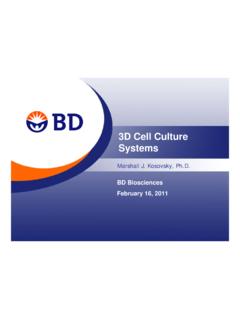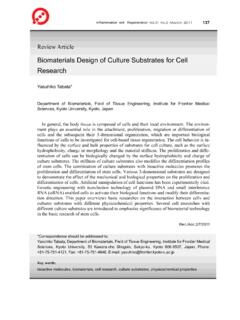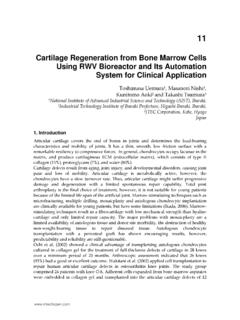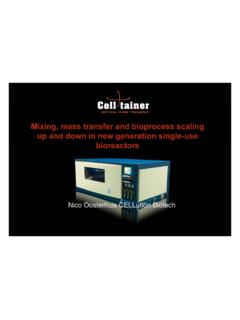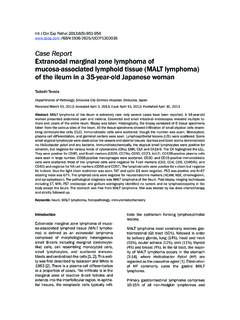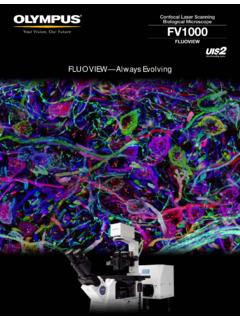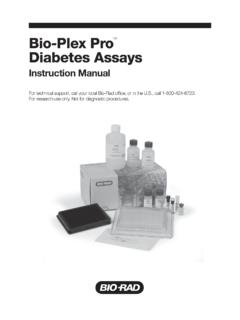Transcription of DIFFUSION TESTING FUNDAMENTALS - PermeGear
1 DIFFUSION TESTING FUNDAMENTALS . INTRODUCTION. When deciding which type of DIFFUSION cell system you need, or before running an experiment with your new DIFFUSION cell or system, it is important to not only be familiar with the equipment but have a well planned experimental protocol with clear objectives. What do you want to know about a particular compound or membrane? Does it matter which type of membrane you use? What membranes are available that will fit your needs? How will you interpret and present the results? There are many parameters to consider, and working out the details beforehand will reduce the number of failed attempts and produce consistency between experiments that is crucial when comparing results. This paper will address basic concepts of DIFFUSION , describe various materials from which to choose for your DIFFUSION study, and describe the components of DIFFUSION cells and DIFFUSION systems. BACKGROUND/TERMINOLOGY.
2 DIFFUSION is, by definition, the random movement of Any compound applied to either tissue or an molecules through a domain driven by a concentration artificial membrane will have a lag time, the time gradient, from high concentration to low concentration. it takes to permeate through the membrane and In vitro DIFFUSION is generally passive DIFFUSION of a diffuse into the receptor fluid and then finally reach permeant from a vehicle in the donor chamber, through a steady state of DIFFUSION . The lag time is the period an artificial or biological membrane into a receptor fluid during which the rate of permeation across the in a receptor chamber, disregarding delivery systems membrane is increasing. Steady state is reached such as iontophoresis and microneedles. The permeant when there is a consistent, unchanging movement is the molecular species moving through or into the of the permeant through the membrane. The tissue/membrane. Permeation is the movement of the amount of time it takes to achieve steady state will permeant through the membrane that encompasses depend on several factors, the permeability of the first partitioning the membrane and then DIFFUSION tissue or membrane being studied, the properties through the membrane.
3 Penetration can occur into the of the compound itself, and the flow rate of the membrane without necessarily diffusing, or passing receptor fluid if flow-thru type DIFFUSION cells are through, the membrane. being used. Flux is the amount of permeant crossing a membrane The permeability barrier is a lipid barrier dependent per unit area into the circulating system per unit time, on the amounts, types, and organizations of lipids and for in vitro permeation this system is the receptor present in a tissue. Permeability of a particular chamber, expressed in units of mass/area/time. tissue does not directly correlate to the thickness Similarly, accumulation is the amount of permeant of that tissue. For example, skin structure varies to crossing a membrane within a certain time, expressed some degree over the human body and different in units of mass/area. Diffusivity is a property of the permeants exhibit different rank orders for various permeant and is a measure of how easily it penetrates skin sites.
4 A specific membrane expressed in units of area/. time. The permeability coefficient (Kp) describes the rate of permeant penetration per unit concentration expressed in distance/time. PermeGear , Inc. -1- I. EXPERIMENTAL DESIGN/EQUIPMENT/PRINCIPLES. Choice of DIFFUSION cells : static or continuous flow Static cell (vertical or Side-Bi-Side): Continuous flow cell or flow-thru cell: Description: Franz type cell or Side-Bi-Side Cell, fixed volume Description: Franz type cell or In-Line Cell, fixed volume receptor chamber, controlled temperature, port to sample receptor chamber, controlled temperature - Franz type cells receptor fluid, stirred receptor fluid (Side-Bi-Side cells allow are stirred, In-Line cells have continuous flow which causes stirring of both the donor and receptor chambers.) turbulence in the receptor chamber and simulates stirring, flow rate is adjustable, permits automated sampling. FRANZ CELL IN-LINE CELL. SIDE-BI-SIDE CELL.
5 Uses: Mimics in-vivo (flow equates blood flow), evaluating compound uptake into membrane, finite or infinite dose Uses: Evaluating compound uptake into a membrane, finite permeation, steady state flux and Kp of compounds (either dose permeation, steady state flux of compounds (either alone or in formulations.). alone or in formulations.) Permeability of the compound &. Permeability of the compound Permeability of the tissue &. Permeability of the tissue Determines rate across membrane (flux). Determines rate across membrane (flux). Determines concentration in receptor chamber Determines concentration in receptor chamber Determines rate of clearance (flow rate). Considerations: 1. If you are using a highly permeable compound with a Considerations: large volume receptor chamber, the large volume reduces the gradient, so build up of the compound in the receptor 1. If you are using a highly permeable compound, the high part is not a problem (sink conditions are maintained).
6 Flow rate necessary to clear the receptor chamber to maintain gradient can result in a large volume of permeant to analyze. 2. If you are using a highly permeable compound with a small receptor chamber, the buildup of compound reduces 2. If you are using a low permeability compound, the flow rate the concentration gradient and therefore slows the flux of necessary to clear the receptor chamber can result in a large the compound (non-sink conditions). volume of permeant for which detection can be a problem. 3. If you are using a low permeability compound, then 3. A smaller receptor chamber requires less permeant to clear detection of the compound in a large volume receptor the receptor chamber which results in less permeant volumes chamber can be a problem. and better detection. PermeGear , Inc. -2- II. MEMBRANE TYPES. 1. Human tissue ex vivo: It may be difficult to obtain sufficient quantities of TISSUE PREPARATION/. normal, healthy human tissue to perform permeability experiments with large STORAGE.
7 Enough sample sizes for statistical analysis. Many laboratories use human cadaver skin obtained from accredited human tissue banks. There might be ethical and Once you have selected the legal considerations in obtaining human tissue biopsies and surgical specimens. membrane you will use for your study, it is imperative that 2. Small animals: Models such as rats, mice, and rabbits have traditionally been used you know the specifics for that in research for human tissue permeability as they are usually inexpensive to purchase membrane such as the source, and maintain. Drawbacks are the tissue areas are usually thinner than human skin age, integrity, and shelf life. If it and have a different morphology resulting in higher compound permeabilities. is human or animal tissue, you 3. Large animals: Monkeys, dogs, pigs, and other large animals have also been used will need to know the health extensively but may be expensive to purchase, especially in the cases of monkeys and age of the animal, time of and dogs.
8 Pig and monkey soft tissue is very similar to human soft tissue in terms of excision, race and gender of the morphology and function, therefore is widely used as a surrogate for human skin. human, site of excision (for skin). and storage conditions before 4. Polymeric membranes: These kinds of membranes are usually used for in vitro utilization. Most skin can be release TESTING (IVRT). According to the FDA SUPAC-SS (May 1997), any appropriate frozen and used at a later date inert and commercially available synthetic membranes such as polysulfone, cellulose acetate/nitrate mixed ester, .. of appropriate size to fit the DIFFUSION cell diameter without affecting permeation. can be used. Usually hydrophilic polymeric Certain tissues degrade quickly membranes with a pore size of m Polymeric membrane and must be used immediately are used. Once set during the IVRT method or kept moist and refrigerated developing phase, the same membrane until use.
9 It is also important should be used for the entire duration of to note if any chemicals were the project. applied to the tissue such as an alcohol wipe that could alter the lipid permeability barrier or 5. Human skin equivalents (HSEs): if there was possible damage These are tissues engineered 3D skin from instruments or mechanical constructs (such as MatTek products) damage. Any damage to tissue that utilize a combination of cultured or alteration of the permeability human skin cells and extracellular barrier can bias your results. matrix components under controlled Consistency in tissue retrieval, culture conditions. The advantage of these tissues is that viability can be handling and storage can maintained. The main disadvantage is minimize erroneous data, and that the permeability of the simulated precise information about the tissue is generally higher than that of in tissue can help to determine if vivo. the results are valid.
10 You can find information pertinent to the tissue type you plan to use and appropriate tissue handling Artificial membranes and animal models can be valuable predictors for compounds technique by referencing and formulations for in vivo use. You can Human skin equivalent published literature. address metabolism, penetration, and distribution of the compound of interest, but be careful about making direct claims for that compound in a specific model to human in vivo use. Photo courtesy of MatTek Corp. pages/products/. epidermft PermeGear , Inc. - 3 - III. DONOR FORMULATIONS. The compound of interest can be prepared in a variety of 2. Vehicle formulation: Also named blank or control formulations - liquid solutions, suspensions, creams, gels, formulation, vehicle formulation is the application dose ointments, lotions, pastes, powders, or adhesive patches. without the active pharmaceutical ingredient (API) or drug The formulation chosen should mimic the real world agent.
